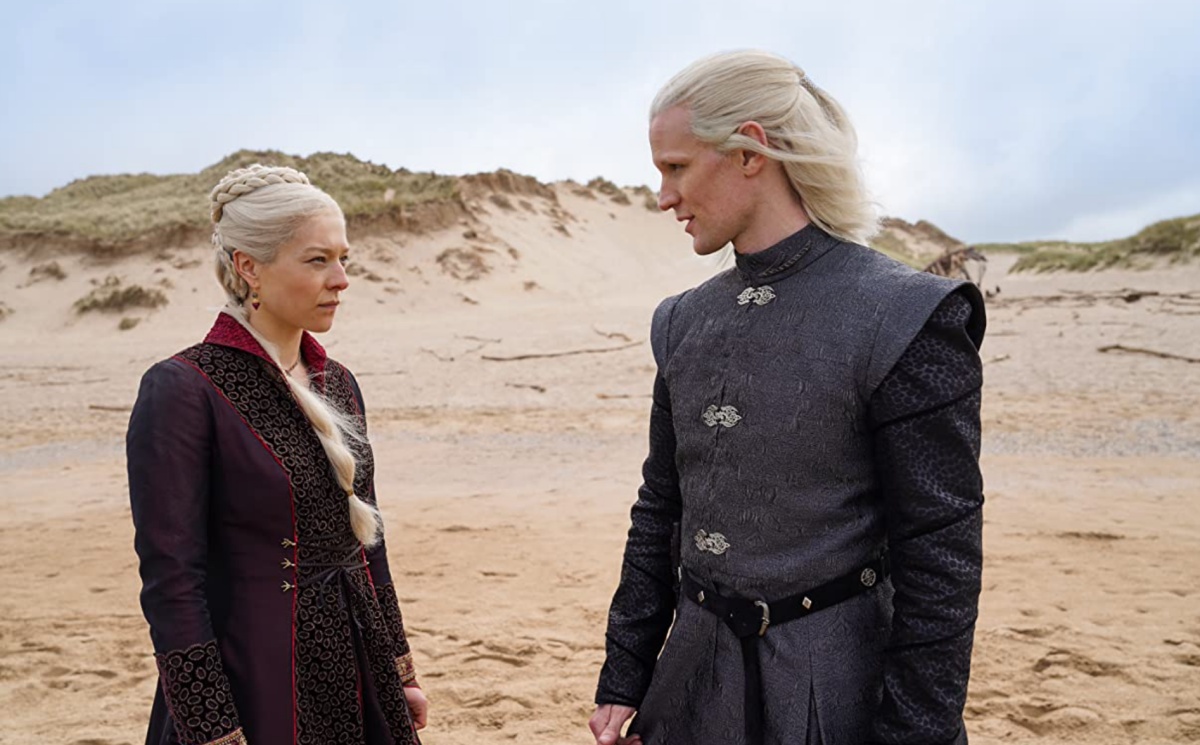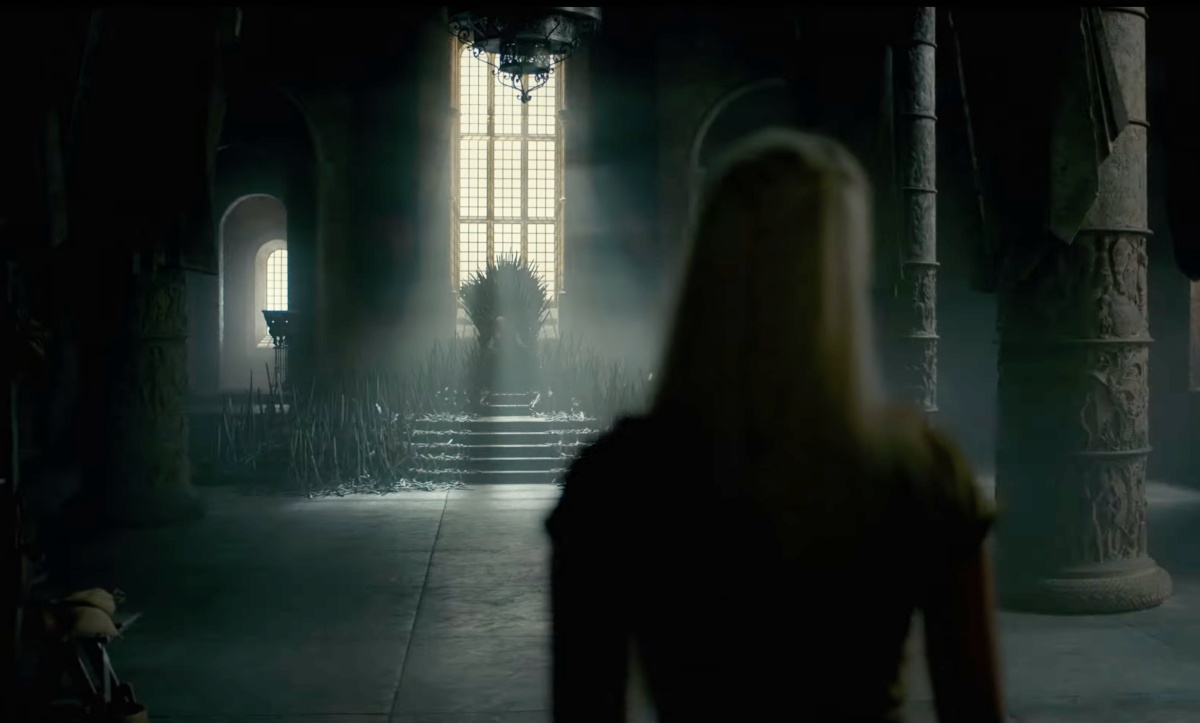A Ranking of the Best (Most Benevolent) Targaryen Kings

Let’s be real, keeping track of the huge ensemble cast in House of the Dragon—including characters who only make appearances through dialogue—can be really confusing. It’s what made the first season of Game of Thrones a little difficult to follow. And now we’re also dealing with about a million people in the same blonde wig. “Which king are you talking about? The one with the weird hair? Oh, okay.” THAT COULD BE ANY OF THEM.
So, let’s talk about the kings. The Targaryens ruled Westeros for three centuries, and within that span of time had 17 kings sit on the Iron Throne—but unfortunately, no queens (unless we count Rhaenyra Targaryen, and if you ask me, she should count). The Targaryen dynasty is an interesting spectrum that ranges from impressive to downright questionable, and in this list, we’re ranking their 10 best rulers. In this case, rather than rank by most notable or horribly infamous, we’re actually looking at the Targaryen kings who did good for the kingdoms. They weren’t all burning things to a crisp.
10. Baelor I the Blessed
Baelor may sound familiar to you because of the Sept named after him, which often made an appearance on the show: the Great Sept of Baelor. Baelor was both a septon and a king and, unsurprisingly, was very devout. In fact, in his piety he refused to sleep with his wife and therefore fathered no children. He also sanctioned the construction of the Maidenvault, where he hid his sisters to keep them “innocent.” Okay, I realize that prefacing Baelor with all these facts may make you question why I put him on this list, but I’m getting there: It’s because of his work in Dorne.
Prior to Baelor’s ascension to the throne, his late brother (and then King) Daeron I attempted to invade Dorne. When Baelor was crowned, his first act was to release the hostages his brother’s men took and forgive his brother’s killers. This would become a trend in his 10-year reign, which—although not always popular among the nobles—proved to be good for everyone’s healing. Oh, and he also walked the causeway that leads to Dorne when he personally returned the hostages, who were riding horses.
Toward the end of his reign, he would make a stonemason the High Septon after fervently believing that the man was the Smith come to life, and later on, a former street urchin (he believed this kid could perform miracles) when the stonemason died. In essence, Baelor is a mixed bag.
9. Aerys I
Aerys reigned during the height of the Great Spring Sickness and had the misfortune of having to deal with the Blackfyre rebellions. Fortunately for him, he had the good sense to appoint his uncle Brynden Rivers—also known as the Blood Raven (yes, he is as ominous and intimidating as that nickname sounds)—to the position of Hand of the King.
Aerys was said to love and enjoy reading over almost anything else—including spending time with his wife. He sired no heirs of his own and acknowledged four different heirs during his lifetime. Many of the persons on his small council advised him to just take another wife if he didn’t like his so that he could have a son, but he said no, remained married, and kept on reading.
Throughout his 12-year reign, he saw the end of the plague, abruptly cut the Second Blackfyre Rebellion before it could escalate, and quelled the third after the capture of Aegor Rivers (interchangeably called Bittersteel). And although the Bloodraven and his men mostly did the heavy work while Aerys kept to himself and his tomes, the king was quick to exhibit a sense of justice. When Bittersteel was brought to the capital to answer for his treason, many wanted to see his head on a spike. Still, Aerys disagreed and extended his bastard uncle the option of saving face by allowing him to take the Black instead. Not a bad run, if you consider all the other Targaryens who’ve sat on the Iron Throne.
8. Viserys I
Viserys had a good head start. He’d inherited the Targaryen dynasty at the height of its power—they had numerous dragons, and Westeros had just seen the long and prosperous reign of Old King Jahaerys come to an end following his peaceful death. Viserys had a loving wife, Aemma, and a beautiful daughter affectionately called the Realm’s Delight, Rhaenyra. As painstakingly and heartbreakingly depicted in the first episode of House of the Dragon, we all probably know by now that Aemma died while giving birth to a long-awaited son, leaving Viserys saddened and also set on naming his daughter as his heir—an unprecedented move for the royal family.
The HBO adaptation compensates for Viserys’ lack of characterization in the source material. House of the Dragon presents him as a pragmatic ruler who, first and foremost, advocated for peace despite the turmoil within his own family. Remembered as Viserys the Peaceful in the show’s narrative, the king is depicted as having fought for Rhaenyra’s birthright even as his body grew weaker and weaker (THAT scene where he walks up to the Iron Throne, anybody?????). In the source material, he simply did not clarify the matter of his succession following the birth of his sons to Alicent Hightower.
Despite all this, Viserys’ greatest failing was not reconciling his own family, which led to one of the bloodiest civil wars Westeros had ever seen: the Dance of the Dragons.
7. Viserys II
Viserys II has the distinction of technically reigning for only a year but actually ruling for decades. As Tyrion Lannister himself once said, “Viserys might have only reigned a year, but he ruled for 15 while Daeron warred and Baelor prayed,” referring to Viserys’ long post as Hand of the King.
The 10th Targaryen king has arguably among the most interesting and fascinating backstories. Born the son of Rhaenyra and Daemon Targaryen during the Dance of the Dragons, Viserys II and his dear brother Aegon III were sent to Essos while his parents clamored and fought to get his mother on the Iron Throne. During the long voyage east, the ship that held the two princes was captured. Aegon managed to escape on the back of his dragon Stormcloud, but Viserys’ dragon egg had yet to hatch. It would be the last time Aegon would ever ride a dragon and would mark the beginning of his miserable life, as he believed—along with the rest of the family—that Viserys had died during the attack.
But he didn’t. Viserys II survived and ended up in Lys, where he grew up under the care of a wealthy family that eventually married him to their youngest daughter. When Aegon III was crowned king, Viserys found his way home and the two brothers were reunited. The maesters often remark that this was probably the one true joy of Aegon’s sad existence and reign. Cue the waterworks. Given that Viserys was the only person he trusted, Aegon named him Hand and he held the position throughout the reigns of two more Targaryen rulers. His time on the small councils kept the realm stable, despite the not-so-colorful reigns of his nephews.
6. Jaehaerys II
Jaehaerys II was the 16th Targaryen king, but is best noted for being Daenerys’ late grandfather. He was initially betrothed to a Tully but was in love with his sister, who loved him as well (if we were ranking by least incestuous, this list would be rough). Their parents were against the match (the fact that their objection is the surprising detail here says a lot, but hey, these are the Targaryens we’re talking about), but in the end, the two siblings eloped. And since their parents married out of love, they felt that they should give the same right to their children.
Jaehaerys, however, did not share the same ideals when it was his turn to be a father. After hearing a prophecy from a woods witch saying that the union of his children would bring forth the Prince That Was Promised, he did the “logical” thing and forced them to marry each other. His son was the Mad King, by the way. The issue of how his son turned out aside, though, Jaehaerys was arguably and quite literally the last good Targaryen king. He reigned for only three years but in that short span of time, he was able to end a Blackfyre threat (despite being considered the least martial among his siblings) and reconciled with many Great Houses that were unhappy under his father’s reign. During his brief period on the Iron Throne, the realm was peaceful. It was the calm before the storm.
5. Maekar I
Being the fourth son of the king, Maekar never expected to reign. In A Feast for Crows, Maester Aemon tells Samwell Tarly that his father once told him that Maekar’s ascension was probably punishment for an accidental blow he’d given his brother during a tourney that ultimately led to his death. Still, Maekar had what it took to be a good king and he was.
Before his ascension, Maekar served as a Targaryen commander during the first Blackfyre rebellion and, although not charismatic or charming like his brothers, he was noted for his leadership skills. He was also a nice father by Westerosi standards. When his fourth son, Aegon (affectionately called “Egg” by everyone in the family), wanted to squire for a hedge knight, he reluctantly allowed him to go but gave him a small sigil should he ever have any need for help. During his reign, he also called forth his son, Maester Aemon, to serve on his Small Council. Aemon refused, stating that it may offend the Grand Maester and so he served his brother on Dragonstone instead.
Maekar reigned during a long and peaceful summer. He died in battle and was succeeded by Aegon—the son allowed to disguise himself as a peasant in order to squire for Duncan the Tall.
4. Aegon I the Conqueror
It’s mandatory to include Aegon I on this list, especially considering that he did kick off the dynasty. That, and, well, he did conquer nearly all of Westeros (save for Dorne). Aegon I was the person behind the creation of the Iron Throne, which is made up of the swords of his fallen enemies (dramatic, but I respect it). During his reign, he conducted many “progresses,” or tours, of Westeros. This was for Aegon I to see firsthand any needs the people may have. In fact, he often traveled with at least six maesters to better educate him regarding each region’s customs.
Aegon did, however, make another attempt at conquering Dorne, which ended horribly and caused the death of his beloved sister-wife Rhaenys, who fell from the sky after her dragon was shot in the eye. Her death would signal the “Dragon’s Wroth”: Aegon and his remaining sister-wife, Visenya, put bounties on the heads of Dornish lords. Several attacks were exchanged between the two parties and it was from this point that the Kingsguard was established. A peace would be brokered with Dorne a few years later when Princess Deria Martell paid the king a visit with the skull of Rhaenys’ dragon and a letter we may never know the contents of. The remaining two decades of Aegon’s rule were relatively uneventful as the realm was at peace.

3. Daeron II the Good
Dareon, the 12th Targaryen king, is remarked upon and celebrated for being the ruler behind one of the dynasty’s greatest achievements: the unification of the Seven Kingdoms, with the ushering in of Dorne peacefully, rather than by conquest. When Baelor the Blessed ascended to the throne, he arranged for Daeron to marry Princess Myriah Martell. As thanks, the couple named their first son after the septon-king. When it was his father’s turn to rule, the two often butted heads. I mean, this guy is called “The Good” and his father is literally Aegon the Unworthy. In fact, as one final act of pissing the other off, his father legitimized all of his bastard siblings as he lay dying.
Still, Daeron claimed what was his and took the Iron Throne, all while treating his now-legitimized siblings honorably (that final screw-you act from his father, though, would ignite the series of Blackfyre rebellions). During his reign, many Dornish men and women felt safe to come to his court, which enabled Daeron to negotiate with Maron Martell to finally begin talks of unifying Westeros. In the end, Maron was married to Daeron’s sister Daenerys, and Dorne was finally part of Westeros.
2. Aegon V the Unlikely
Affectionately called Egg by those closest to him during his youth, Aegon was the fourth son of a fourth son, which earned him the moniker “The Unlikely” upon his ascension to the Iron Throne. Maester Aemon, Aegon’s favorite brother, described Aegon as having an innocence and sweetness. He was bold and compassionate, and is best known for his stories as a young squire for Duncan the Tall.
His father Maekar had wanted him to train as a knight, to which Aegon agreed with the condition that only Duncan would teach him. The hedge knight had a condition of his own: that young Aegon accompany him on the road and learn to live humbly. According to Duncan, this would let him become better than his older brothers Daeron and Aerion (the dude who died drinking wildfire after thinking it would turn him into a dragon). And the knight was not wrong. With his head shaved to hide that signature Targaryen-silver hair, Aegon purely went by Egg and accompanied Duncan wherever he went. You’d think that his actual experience living with normal folk would have been a plus for the Great Council, but several of the lords felt that he’d turned into “half a peasant.” Still, the Iron Throne passed to him after Maester Aemon (who was older) refused and insisted that Aegon should reign.
It was a terrible winter when Aegon’s reign began, so he sent massive shipments of food and grain to the north. There were also several uprisings (mostly due to the Blackfyre rebellions) but Aegon managed, with the help of Duncan, whom he made Lord Commander of the Kingsguard. He also granted numerous rights and reforms for the smallfolk, which gained him their love but lessened his popularity with the nobles.

1. Jaehaerys I the Old King
We all saw this one coming. A lot can be said about the Old King. (I mean, he did rule for 55 years.) There’s the wonderful story about Jaehaerys and his wife Good Queen Alysanne, his love for his dragon Vermithor, and his countless progresses all over Westeros throughout his reign. It was during his time on the Iron Throne that the barbaric first-night law was abolished after strong urgings from Alysanne, who had listened to the grievances of countless women during her women’s councils.
He placed taxes on luxury goods to generate income for the throne without affecting the small folk (smart). He was also the ruler behind the construction of the Kingsroad (in addition to several other road systems and public works), and was the one who provided the Night’s Watch with the New Gift.
Jaehaerys’ reign is often marked as the most prosperous period for both Westeros and the Targaryen dynasty. There is even an old saying that goes, “He [Jaehaerys] bound the land together, and made of seven kingdoms, one.”
(featured image: HBO)
Have a tip we should know? [email protected]
